

Seven islands, seven worlds: the Canary Islands should all be seen. Which island should you choose as your holiday destination? And in which resort to stay?
On all islands there are beautiful beaches and interesting attractions, but each one has its own distinct identity. Choosing where to stay in the Canaries depends a lot on the type of holiday you want to take and the time you have available.
The four eastern islands (Tenerife, Gran Canaria, Fuerteventura and Lanzarote) are the easiest to reach as they are served by low-cost flights and can be considered either for a long holiday or a weekend getaway. They are the most touristy islands and therefore offer a greater choice of accommodation and services.
The three western islands (La Gomera, El Hierro and La Palma) are not connected by direct flights, so it is necessary to arrive at one of the larger islands and from there travel by internal flight, which is usually very expensive, or by ferry, which is very slow. In particular, La Gomera and El Hierro are the most remote and, consequently, the least visited.
Not suitable for a short holiday, the Western Canaries are the ideal destination for those who want to treat themselves to a trip of at least ten days, or longer, in order to recharge their batteries. No nightlife, no noisy beaches and souvenir shops: you come here to immerse yourself in nature and enjoy absolute peace. It will not take you long to adjust to the slow pace of life on these islands and to become attached to their inhabitants.
This article is designed to help you figure out which island is best suited for your dream holiday and where to look for your accommodation.
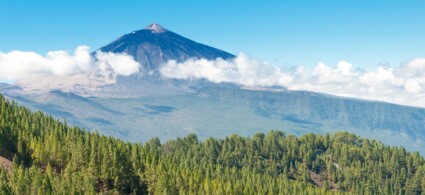
The largest island of the Canarian archipelago is Tenerife, the most urbanised and most visited. Its tourist reputation is mainly linked to the beaches and beach resorts on the south coast, but Tenerife is a continent in miniature and encompasses very different landscapes.
Significant to this diversity is the fact that the island’s symbol is… a mountain! And not just a little higher than a hillock, but the highest mountain in Spain: we are talking about Pico del Teide, a 3718-metre peak that is covered in snow every winter.
Certainly, Tenerife is the island that offers the greatest variety of experiences. Lazy days at the beach, boat trips, hiking in the mountains, beer-fuelled nightlife and happy hours, urban atmospheres, museums and cultural events, shopping in luxury boutiques or craft markets… you can do it all in Tenerife. From alternative to exclusive holidays, with everything in between.
Santa Cruz, the island’s capital, is the recommended choice for those who love urban atmospheres, those who want to travel by public transport and those who want to stay for a longer period of time.
The most popular destination for seaside holidays in Tenerife is Playa de las Americas, a classic resort with all-inclusive packages, mega-hotels, well-equipped beaches and entire streets of nightclubs. It is recommended for young people and families looking for amenities and entertainment.
More tranquil are the resorts of Puerto de Santiago, Playa de la Arena and Los Gigantes, suitable for families, the elderly and people of all ages wishing to live in contact with the local population. The choice of hotels and holiday homes is very good, while public transport is scarce so renting a car is strongly recommended if you are staying here.
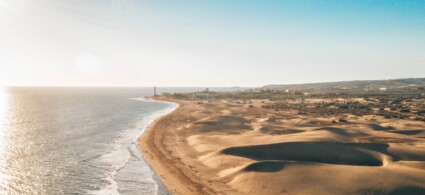
Gran Canaria is the other well-known name for mass tourism. The third largest island of the archipelago, it rivals Tenerife in number of resorts, holiday villages, hotels with hundreds of rooms and in variety of landscapes. You will feel like you are experiencing three completely different holidays if you explore all areas of the island: the fertile and green north, the arid south and the mountainous centre.
Cultural life is also lively and the traditional festivities, especially those related to Carnival, Holy Week and the cult of San Juan, are very popular.
The south of Gran Canaria has long since been colonised by northern Europeans who abandon their cold countries for a week or forever and come here in search of a good climate all year round. The top resorts in this area are Maspalomas and Playa del Inglés.
The north has remained more authentic and has a more distinctly Spanish character. It is recommended for couples seeking romantic accommodation, those who do not like crowded tourist resorts and hiking enthusiasts. Look for accommodation in Arucas and Firgas.
The capital Las Palmas de Gran Canaria is a modern city, perfect for a short holiday or to combine lazing on the beach and shopping.
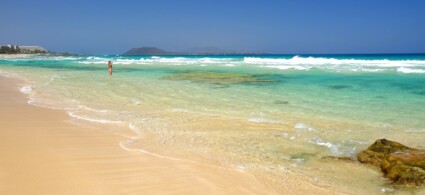
Extinct volcanoes, dunes and cliffs characterise the landscape of Fuerteventura, the windy island, the top destination in the Canaries for surfing, windsurfing and kitesurfing. The long Playa de Sotavento de Jandía in the south-east of the island has been home to the Windsurfing World Championship for more than ten years; experienced surfers and beginners also flock to the beaches on the north coast.
Fuerteventura is also one of the best choices for those who want a totally relaxing beach holiday. You can retreat to one of the magnificent resorts and holiday villages in Costa Calma, in the south, and Caleta de Fuste, in the centre of the island, and enjoy lazy days on the beautiful sandy beaches and poolside bars. The east coast is the best for beach holidays because it is low-lying and the beaches are long sandy shores, safe and equipped with all amenities. Nestled between high cliffs, the beaches on the west coast are few and generally small and lack amenities.
If you prefer active holidays but adrenalin sports are not your thing, you can hike or mountain-bike along the hiking trails that criss-cross the island from north to south and from east to west.
The island’s capital, Puerto Rosario, is an unglamorous location. Better to stay in Corralejo (a pretty seaside town a stone’s throw from the famous Saharan sand dunes) or El Cotillo if you want to holiday in the north of the island, Morro Jable if you prefer the south.
The rural houses in the interior are ideal for those who want to forget everything and everyone, but if the idea of a remote place scares you a little, look for accommodation in Lajares, a pretty village with a ‘hippy’ reputation that is easy to reach by car and bus.
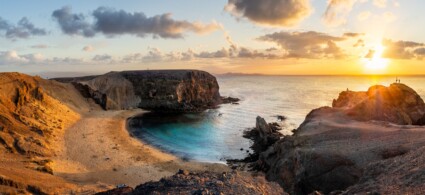
The fourth largest island, Lanzarote is much less populated than Tenerife and Gran Canaria. It has had a past as a star of mass tourism and organised travel, but thanks to the intervention of local artist Cesar Manrique and environmental organisations, it has been able to preserve its biodiversity and traditional architecture. Today, it is the favourite Canary Island of independent travellers opposed to all-inclusive resorts and mega-hotels that disfigure the landscape.
Indeed, it would be a shame to disfigure such a beautiful landscape. Lanzarote is the Canary Island that most clearly betrays its volcanic origin: there are more than 300 volcanic cones on its surface and the interior of the island, with its desolate expanses of lava rock, is often described as a ‘lunar’ landscape.
Located in the central part of the island, along the east coast, the capital Arrecife is a good base for exploring Lanzarote. It is a simple but pretty town, without mundane or touristy excesses, and has a nice sandy beach; from here you can easily move around with a hire car to all the main places of interest.
Playa Blanca is a former fishing village now devoted to tourism, suitable for couples, families, hikers and generally those looking for a mix of comfort and tranquillity. If you are looking for amenities and nightlife, better to look for accommodation in Puerto del Carmen.
The interior of the island is the best choice for those who enjoy rural tourism and are looking for a house or b&b in the quiet. The most beautiful villages are Haria and Teguise.
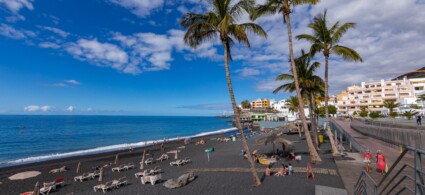
Not to be confused with the city of Las Palmas in Gran Canaria, La Palma is the greenest island of the archipelago and fully deserves its nickname ‘Isla Bonita‘ (Pretty Island). Less touristy than the four eastern islands and more inhabited than the other two western islands, La Palma seems to have achieved its own perfect balance.
Like its neighbour El Hierro, La Palma is a geologically young island with a rugged coastal profile. Beaches are often rocky coves that are difficult to reach and lack amenities, yet there is no shortage of lovely dark sandy beaches, natural swimming pools and even equipped beaches suitable for those who like comfort.
Another pride of La Palma are the clear skies that offer excellent visibility conditions for astronomy scholars and romantic souls who like to stay with their noses to the sky and admire the stars.
The island’s capital, Santa Cruz de La Palma, is a pretty, human-scale town that retains its colonial charm. A large proportion of the island’s flats, hotels and guesthouses are concentrated here. Another option for those wanting to stay in the city is Llos Llanos de Aridane, less charming but more lively. Surrounded by a fertile valley, it is a short distance from beautiful beaches.
If you prefer a more traditional atmosphere, look for a b&b in Breña Baja, Breña Alta, El Paso or a rural house in the inland villages.
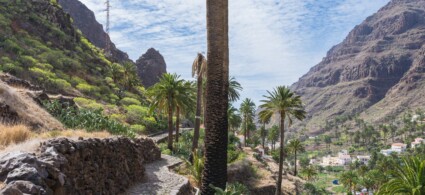
Accessible by ferry from the port of Los Cristianos in Tenerife, La Gomera is almost always the destination for a fleeting day trip. It does not deserve it, especially if you are a keen hiker.
The entire island is criss-crossed by fascinating trails and trekking routes surrounded by lush vegetation. The most beautiful of these wind their way through the Garajonay National Park, an intricate laurel forest in the heart of the island, and include both easy walks within everyone’s reach and more strenuous hikes.
The only major centre on the island is the capital San Sebastián de La Gomera, the port of arrival for ferries from Tenerife. Look for accommodation in this town if you want shops, bars and bus stops within easy reach.
The village of Villahermoso and the Valle Gran Rey area are recommended for those who want to immerse themselves in the traditional culture of the island. For those who want to live the beach life and think that holidays are synonymous with resorts Playa Santiago is an almost obligatory choice.
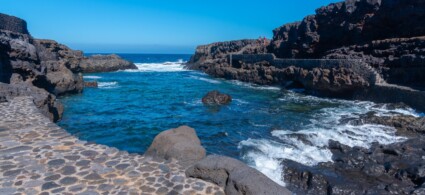
El Hierro is the smallest, westernmost and most difficult to reach of the Canary Islands: the last European bastion before the enormous expanse of water that separates our continent from America. Until a few years ago, it was unknown even to tourist agencies, but the growing interest in nature holidays and alternative destinations has made El Hierro emerge from its placid anonymity (which perhaps the islanders didn’t mind so much…).
The few visitors to this surprising island are enchanted by the variety of its landscapes. The coast is high and jagged, with steep cliffs where the ocean waves break vigorously, the interior hides forests reminiscent of a mountain landscape and meadows bordered by stone walls reminiscent of Ireland, while on the eastern tip of the island grow trees with trunks bent at 90° by the force of the wind.
Some of El Hierro’s most beautiful beaches are difficult to reach and unsuitable for swimming due to strong currents, but there are many natural pools carved into the rock on the island where it is possible to bathe safely.
The only town on the island is the capital Valverde, located inland; Tamaduste and La Caleta are the nearest seaside resorts. The village of La Restinga is an excellent base for diving.
The number of hotels and b&b’s in El Hierro is still limited, while there is a greater choice of rural houses. These are perfect for experiencing the special atmosphere of this remote island.
Use the form below to check room availability and prices in real time.